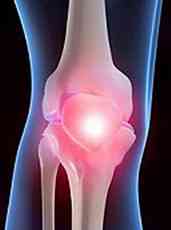Joint health concerns often occur when the cartilage that cushions the ends of bones in your joints gradually deteriorates. The slick surface of the cartilage becomes rough, which I associate with fine-grit sandpaper. Imagine rubbing the back of your hand with superfine grit sandpaper constantly, eventually, you will wear a hole in your skin. The same occurs in your joints as the rough surface wears away the spongy connective tissue that is there to prevent bone rubbing on bone. As pieces of cartilage wear away, a normal response by your immune system triggers increased blood flow and fluids into the joint to help repair the damage. Regretfully, this influx of fluids triggers more pressure inside the joint and leads to pain and discomfort.
Common symptoms:
- Pain in the affected joint and the surrounding areas (even muscles)
- Tenderness near the joint when you apply light pressure to it.
- Stiffness that may be most noticeable when you wake up in the morning or after a period of inactivity.
- Loss of flexibility to the point where you can’t move your joint through its full range of motion.
- You may hear or feel a grating sensation when you use the joint.
Factors that may increase your risk of osteoarthritis include:
- Age
- Gender- Women seem to be more prone to this condition.
- Weight- Carrying extra body weight puts added stress on weight-bearing joints, such as your hips and knees.
- Joint injuries- Like those that occur when playing sports or from an accident.
- Certain occupations- Repetitive stress on a particular joint.
- Other Health Conditions- Elevated blood sugar and some autoimmune conditions can contribute.
The best approach to addressing this type of joint degradation is to make every attempt to reduce the underlying cause(s) and help support the body’s protective measures. For people with weight issues, supplements for weight control will eventually benefit by helping reduce the added pressure, primarily on the hips, back, and knees. If someone has joint problems due to repetitive motion, trauma from an injury/surgery, or stress-related pressure on a joint, the underlying issue is most likely two things; connective tissue damage/decline and inflammation.
When discussing connective tissue damage, there are a few go-to ingredients: Native type II collagen (Collavant n2), hyaluronic acid matrix (Mobilee®), and Glucosamine/Chondroitin.
Collavant n2
Collavant n2 is a native type II collagen. Native type II collagen can also be referred to as undenatured type II collagen. Don’t get caught up in the technical names. Simply put, native (undenatured) refers to the fact that the collagen is in its original form and has not been modified or broken down by man. Think of it as being in its natural form.
Collavant n2 differs greatly from hydrolyzed collagen. Here are some of the differences:
- Dose required.
- Collavant n2 requires a very low dose of 40mg per day.
- Hydrolyzed collagen requires multiple grams or 50-100+ times more.
- Absorption
- Collavant n2 is not absorbed into the bloodstream.
- Hydrolyzed collagen needs to be absorbed to yield its benefits.
Note: Because Collavant n2 is not absorbed, the chance for interactions and side effects are eliminated
- How they work
- Collavant n2 triggers a positive response by the immune system to turn off the attack on healthy collagen.
- This helps protect and repair collagen and support joint health.
- Hydrolyzed (broken down into smaller parts called peptides or amino acids) collagen requires larger amounts to be consumed for the body to use those nutrients to rebuild and repair collagen. The body uses amino acids and peptides to build collagen and muscle and other nutritional needs by the body.
Research studies show that Collavant n2 helped significantly improve pain, function, and quality of life after just 3 months of taking the small dose of 40mg daily.
While consuming native type II collagen has shown to benefit joint health, combining it with hydrolyzed collagen would also be a great addition. Providing the body with the tools (nutrients) it needs to help rebuild collagen while you are protecting it from potential damage would be a powerful one-two punch for joint health.
Mobilee®
Mobilee® is a naturally occurring matrix of hyaluronic acid, polysaccharides, and collagen. Together, they form a patented combination proven to increase the production of hyaluronic acid and decrease the release of fluid into the joint, which triggers pain and discomfort. Like Collavant n2 above, only a small dose of 80mg per day is required to achieve the desired benefits.
Why is the production of hyaluronic acid (HA) important?
Using hyaluronic acid for joint problems, especially in the knees, can increase the density of the synovial fluid. (Synovial fluid is also known as “joint fluid”. It is a thick liquid located between your joints and helps cushion the ends of bones and reduces friction when you move your joints). Hyaluronic acid also delays further cartilage breakdown, forming a protective layer between joints to relieve pain.
In most cases, people supplement with just HA and rely on the body to break it down so the components can be absorbed into the body and then reconstructed into new HA. In the case of Mobilee®, science has shown that even though it already contains HA as part of its matrix, it also helps the body produce more HA.
Glucosamine and Chondroitin
If you have been following me for a long time, you probably realize I haven’t brought these two ingredients up in a while. Most of my focus over the past several years has been on inflammation and not connective tissue joint health. Perhaps my age (59) or my own personal journey has opened my eyes to these two well-recognized joint ingredients. Glucosamine and chondroitin are natural compounds found in healthy cartilage.
According to the Arthritis Foundation website, “glucosamine and chondroitin protect cells called chondrocytes, which help maintain cartilage structure.” Studies with glucosamine sulfate have shown benefits in reducing the need to take NSAIDS[i] and reducing the risk of knee OA.[ii] Studies with Chondroitin sulfate show decreased joint pain.[iii]
Keep in mind that when we are addressing joint discomfort from a structural direction, meaning we are trying to protect or repair connective tissue, the process takes months to achieve or realize the impact. These approaches above do not directly impact the swelling in your joints and are designed to help support the body’s natural functions, not stop them. My rule of thumb is to allow a minimum of 90 days of supplement consumption before moving on to something else. In those cases where joint problems have existed for years, it may take 6-12 months of supplementing to realize any significant changes in joint health, mobility, flexibility, and reduction of discomfort.
Since the above ingredients may take more time than you are willing to endure, there are a few great supplement ingredients you may wish to add to your supplement regimen to provide relief. Here are a few of my personal favorites (I take them): HydroCurc® and Levagen®+, and Boswellia.
HydroCurc®
HydroCurc® is the world’s most bioavailable curcumin (single dose), meaning it gets into your body quickly. HydroCurc® has 6-published clinical studies, of which one specifically addresses joint pain. A small dose of 500mg of HydroCurc® taken once daily showed fast-acting (just five days) joint pain relief and was well tolerated.
Levagen®/Levagen®+
Levagen® or Levagen®+ are well studied regarding our topic. Results have shown improvements in joint pain, stiffness, and function while improving quality of life. Another study with Levagen®+ on acute joint pain showed a significant reduction in pain scores after three days.
Boswellia
There are several branded ingredients from boswellia. In short, studies with boswellia have shown a fast reduction in pain and improvements in knee function.[iv]
I think combining these ingredients with an ingredient like Collavant n2 for my joint health needs is the way to go. I had a knee injury years ago while running and opted to “live with it.” I find that by keeping active (cycling), walking, and taking my supplements to support joint health are working for me. Only recently have I made the move to add native type II collagen to my daily supplement program.
[i] Rovati LC, Girolami F, D’Amato M, Giacovelli G. Effects of glucosamine sulfate on the use of rescue non-steroidal anti-inflammatory drugs in knee osteoarthritis: Results from the Pharmaco-Epidemiology of GonArthroSis (PEGASus) study. Semin Arthritis Rheum. 2016 Feb;45(4 Suppl):S34-41. doi: 10.1016/j.semarthrit.2015.10.009. Epub 2015 Oct 29. PMID: 26632505.
[ii] Runhaar J, Deroisy R, van Middelkoop M, Barretta F, Barbetta B, Oei EH, Vroegindeweij D, Giacovelli G, Bruyère O, Rovati LC, Reginster JY, Bierma-Zeinstra SM. The role of diet and exercise and of glucosamine sulfate in the prevention of knee osteoarthritis: Further results from the PRevention of knee Osteoarthritis in Overweight Females (PROOF) study. Semin Arthritis Rheum. 2016 Feb;45(4 Suppl):S42-8. doi: 10.1016/j.semarthrit.2015.11.001. Epub 2015 Nov 19. PMID: 26806185.
[iii] Singh JA, Noorbaloochi S, MacDonald R, Maxwell LJ. Chondroitin for osteoarthritis. Cochrane Database Syst Rev. 2015 Jan 28;1(1):CD005614. doi: 10.1002/14651858.CD005614.pub2. PMID: 25629804; PMCID: PMC4881293.
[iv] Sengupta K, Alluri KV, Satish AR, et al. A double blind, randomized, placebo controlled study of the efficacy and safety of 5-Loxin. Arthritis Res Ther 2008;10:R85

